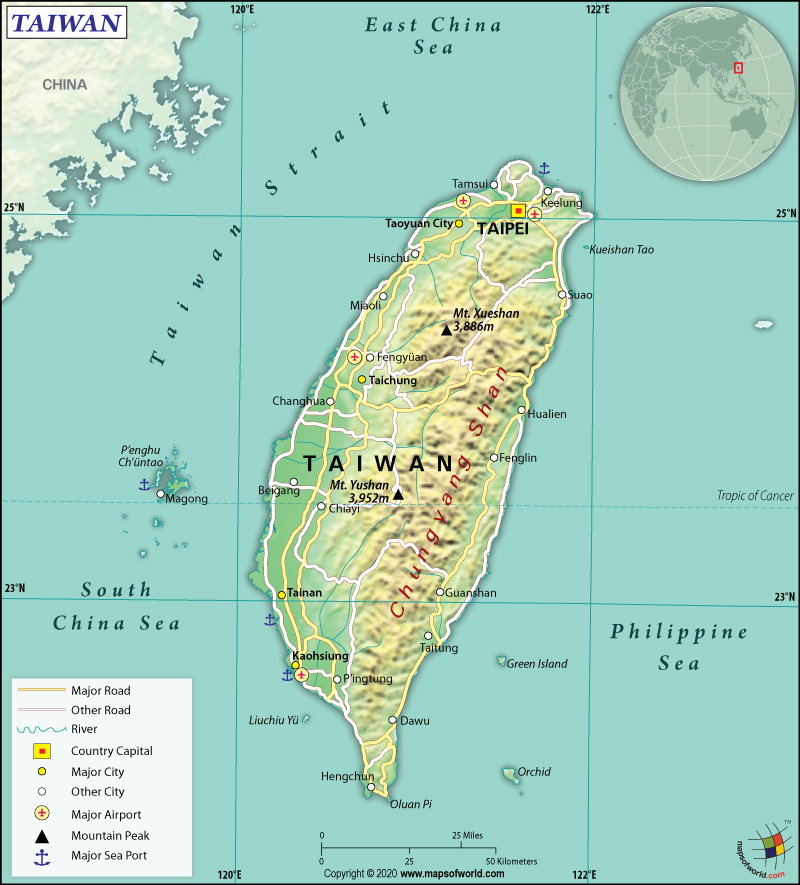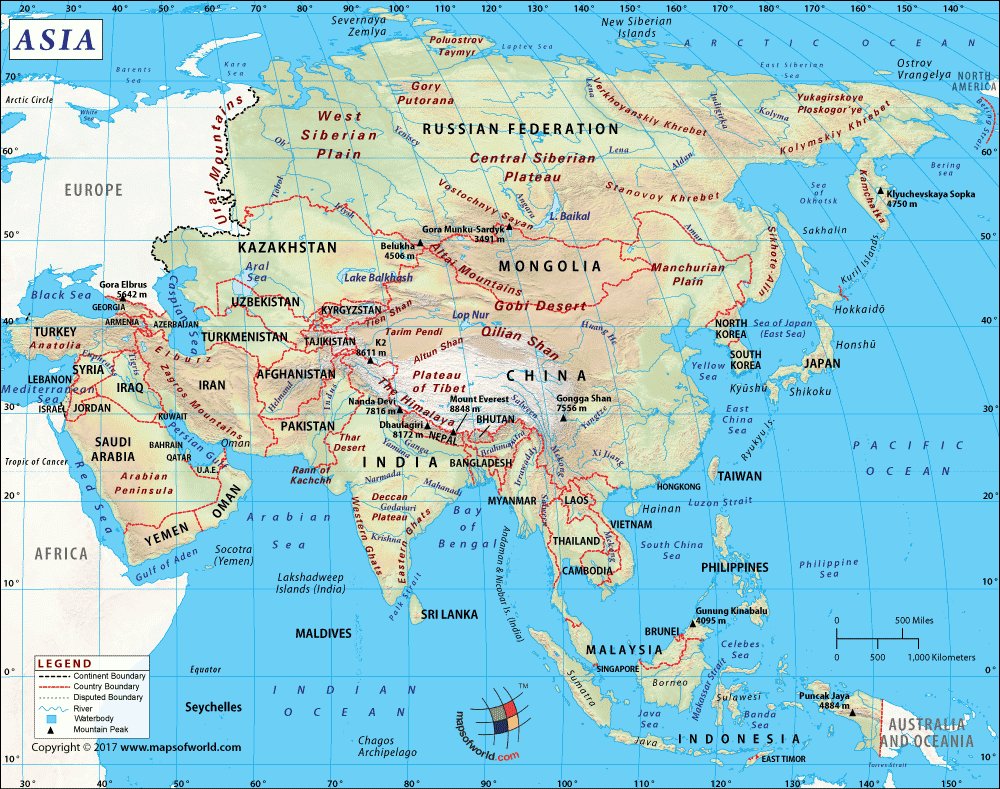What are the Key Facts of Taiwan?

|
Official Name |
Republic of China |
|
Continent |
Asia |
|
Capital |
Taipei |
|
Largest City |
New Taipei |
|
Coordinates |
23.500000, 121.000000 |
|
Area |
13,976 sq. mi ( 36,197 sq. km) |
|
Land Boundaries |
0 mi ( 0 km) |
|
Coastline |
973 mi ( 1,566.3 km) |
|
Currency |
New Taiwan dollar (NT$) (TWD) |
|
Neighboring Countries |
China, Japan, Philippines |
|
Population |
23,780,452 (2018 est. ) |
|
Official Languages |
Formosan languages, Hakka, Hokkien, Mandarin, Matsu, Taiwan Sign Language |
|
Major Religion |
Buddhism, Taoism |
|
National Day |
10 October (Double Ten Day) |
|
National Anthem |
“Zhonghua Minguo guoge” |
|
Form of Government |
Unitary semi-presidential republic |
|
President |
Tsai Ing-wen |
|
Premier |
Su Tseng-chang |
|
GDP per capita (PPP) |
$ 53,023 (IMF, 2018) |
|
GDP per capita (nominal) |
$ 24,971 (IMF, 2018) |
|
HDI |
NA |
|
Literacy Rate (%) |
NA |
|
Space Agency |
National Space Organization (NSPO) |
|
Military Expenditure Ranking |
22 (SIPRI, 2017) |
|
No. of Olympic Medals |
24 (as of 2018) as Chinese Taipei |
|
Driving Side |
right |
|
Calling Code |
+886 |
|
Time Zone |
UTC+8 (National Standard Time) |
|
Internet TLD |
.tw |
Where is Taiwan?
Taiwan is an Eastern Asian country that is located off the southeastern coast of China and north of the Philippines. It borders Taiwan Strait, the South China Sea, Philippine Sea, and the East China Sea.
What is the Geography of Taiwan?
The total area of Taiwan is 36,197 sq. km (13,976 sq. mi), out of which 32,260 sq. km (12,456 sq. mi) is land area and 3,720 sq. km (1,436 sq. mi) is water area. It has no land boundary but has a 1,566.3 km (973 mi) long coastline.
Around 2/3rd of the total landform in Taiwan consists of rugged mountains. Chung-yang Shan mountain range dominates the landscape. It has around 200 mountain peaks that exceed 3,000 m (9,843 ft). While the highest elevation point of this country is Yu Shan at 3,952 m (12,966 ft), the lowest point is the South China Sea at 0 m (0 ft). The mean elevation is 1,150 m (3,773 ft).
There are five major mountain ranges in Taiwan and they are Central Mountain Range, Xueshan Range, Yushan Range, Hai’an Range, and Alishan Range. Besides Yushan, the other major mountains are Xueshan, Xiuguluan, Mabolasi, Nanhu, Guan, and many more.
The rolling hills dominate the western parts of the central mountain and they descend gently from north to south to a relatively flatter region. The island is punctuated by rivers and other water bodies such as hot sulfur springs, and many stream vents.
Earthquakes take place frequently on this island. 15,000-to-18,000 earthquakes take place every year, out of which 800-to-1,000 earthquakes can be noticed by people. The central mountains give rise to around 150 rivers/streams (large). Major rivers of Taiwan are Zhuoshui, Gaoping, Zengwun, Dahan, Tamsui, and many more. Sun Moon Lake is the largest water body in the country.
The climatic condition in most parts of this country is subtropical. Only southern Taiwan has a tropical climate. The summertime lasts from April-to-May and September-to-October. This season remains hot and lasts for a longer period of time.
The winter season lasts for a shorter period of time and is usually mild. However, snowfall takes place in the mountainous regions and occasionally at the lower elevations in the northern regions. 70 °F (21 °C) is the average annual high temperature on Taiwan Island. In the winter season, elevation plays an important role. However, during summertime, elevation doesn’t make much of a difference. The temperature of the island is moderated by the warm Japan Current known as Kuroshio, which flows in the northern direction to the east of this island nation.
This island gets a lot of rainfall across the year. The annual precipitation level in this country is around 2,590 mm (102 in). The eastern parts of Taiwan, as well as the mountainous regions, get heavier rainfall. The wet-dry seasonal monsoon wind pattern determines the distribution of rainfall in the country.
Southeastward-blowing winds induce rainfall in the northern regions of Taiwan during winter. The southern part of this country remains dry during winter. However, during summer, the north remains dry and southern parts get more rainfall.
Taiwan is affected by tropical cyclones, usually called typhoons, especially during late summer to early fall. These typhoons cause considerable damage to the crops and can also lead to severe flooding.
What is the Economy of Taiwan?
Taiwan is one of the top-10 largest economies in Asia. This developed capitalist economy has been categorized among the high-income economies by the World Bank. The nominal GDP of this country increased at a rate of 2.6% in 2018 (less than 3.1% growth rate in 2017) to reach US$ 589,906 million.
The economy of Taiwan is dependent heavily on export, mostly on the export of electronic items, petrochemicals, and machinery. It has become the world’s most technologically advanced computer microchip maker.
In 2018, the total value of export was US$302 billion and the total import was US$272 billion, thereby generating a positive balance of trade of US$30 billion. The major export items of the country are Refined Petroleum, Silver, Coated Flat-Rolled Iron, Flat-Rolled Stainless Steel, and Copper Foil. The major import items are crude petroleum, soybeans, coal briquettes, refined petroleum, and corn.
As per the Directorate-General of Budget, Accounting and Statistics, the unemployment rate of this country was 3.71% in 2018. The latest available data shows that there are around 130,000 people under the poverty level in Taiwan, which is around 1.78% of the total population.
What is the Transportation System of Taiwan?
Taiwan has a 43,206 km (26,847 mi) long roadway, out of which 42,793 km (26,590 mi) are paved and the rest 413 km (257 mi) is unpaved. This roadway system includes 737 km (458 mi) of expressways as well as 1,348 km (838 mi) of highways.
There are 1,613.1 km (1,002 mi) of railway network available in the country, out of which 345 km (214 mi) is standard gauge, 1,118.1 km (695 mi) is narrow gauge, and 150 km (93 mi) is 0.762-gauge track (belonging to TaiPower, Taiwan Cement, and the Forestry Bureau).
There are 37 airports in this island nation, out of which 35 are paved and 2 are unpaved. 31 heliports are also there. The major seaports of the country are Taichung, Hualian, Kaohsiung, and Keelung. 267 merchant marine ships are there in Taiwan.
What International Organizations is Taiwan part of?
IOC, BCIE, WTO (Taipei, China), ADB (Taipei, China), APEC (Chinese Taipei), ITUC (NGOs), SICA (observer), ICC (national committees)
Related Links:


